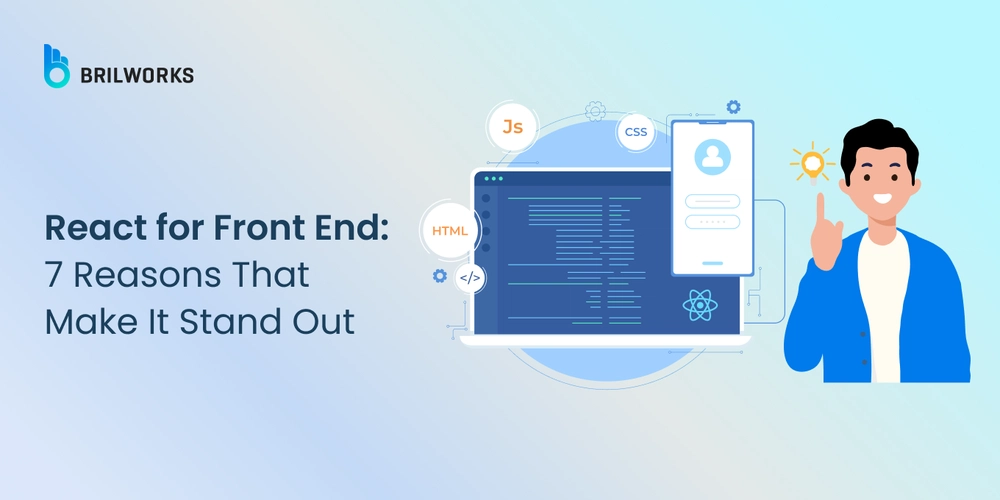React for Front End: 7 Reasons That Make It Stand Out
Today front end development has moved past HTML static pages. There are multiple libraries and frameworks at one's disposal to create dynamic web pages. Among those, React takes the crown. Developers need to keep up with user expectations like fast, responsive, and dynamic web applications. React for front end development is preferred for this reason mostly, as it allows developers to keep up with user requirements. React, also known as ReacJS, has evolved multiple times, and new versions of React keep coming out with better features. JavaScript being one of the most popular programming languages, having a dynamic UI library such as React is useful. In this article, we’ll dive into what makes React a top choice for front-end developers. From its core features to how it compares with other tools, you’ll get a complete picture of why React continues to dominate the front-end space—and whether it’s the right fit for your next project. What is React? React is a JavaScript library used for building user interfaces, particularly for single-page applications (SPAs). It was developed by Facebook in 2011 and open-sourced in 2013. Since then, it has become one of the most popular tools in front-end development—and for good reason. At its core, React focuses on helping developers build interactive and reusable UI components. Instead of thinking about the full-page refreshes like in traditional websites, React encourages a component-based architecture, where each piece of your UI (like a button, for, or navbar) is treated as its own self-contained element. One of the standout features of React is the virtual DOM. This is a lightweight in-memory representation of the actual DOM on the web page. Whenever there’s a change in the UI, React compares the new virtual DOM with the previous one, identifies the changes, and updates only the necessary parts of the real DOM. This process, known as reconciliation, helps boost performance and creates a smoother user experience. Another key concept is JSX—a syntax extension that lets you write HTML-like code within JavaScript. JSX makes it easier to visualize the structure of your components and keeps your markup and logic close together, which many developers find intuitive. Here’s a quick example of what JSX looks like: `function Welcome() { return Hello, welcome to React!; }` React isn’t a full-fledged framework like Angular. Instead, it focuses solely on the view layer of your application. However, that is why it is also a preferred choice for using React for mobile app development as well. Why Use React for Front-End Development? With so many front-end tools out there, you might wonder—what makes React stand out? Why are so many developers and companies choosing React for front end projects? Here’s a closer look at the key reasons why React has become a popular solution for modern front-end development. 1. Component-based architecture By dividing user interfaces into separate, reusable components, React's component-based methodology enables you to create them. Development becomes more modular and scalable as a result of each component managing its own state and logic. Simply modify the props as necessary, and you can create a button once and use it throughout your entire application. Especially on big projects, this structure facilitates team collaboration, enhances maintainability, and encourages better code organisation. 2. Improved performance with virtual DOM To improve rendering speed, React makes use of a virtual DOM. Every time something changes, React makes a virtual copy of the DOM, determines what changed, and updates just those particular sections rather than the entire page. React apps feel quick and responsive thanks to this focused approach, even when managing large amounts of data or UI changes. 3. Declarative programming style Declarative programming is encouraged by React. Instead of giving the browser step-by-step instructions, you just specify how the user interface (UI) should appear for a particular state, and React takes care of the rest. This facilitates reading and debugging your code. React automatically re-renders the appropriate portions of the user interface when your data changes; no manual DOM manipulation is required. 4. Strong ecosystem and community support React has a sizable developer community and is supported by Meta (Facebook). This implies that you will almost never encounter an issue that hasn't been resolved—or at the very least, addressed. Numerous tools and libraries have been developed around React, ranging from routing libraries like React Router to state management programs like Zustand and Redux. Additionally, there are a ton of open-source projects, job postings, tutorials, and courses available for you to learn from. 5. Flexibility and interoperability React works well with other frameworks, in contrast to some that are all-or-nothing. It can be used in conjunction with other JavaScript

Today front end development has moved past HTML static pages. There are multiple libraries and frameworks at one's disposal to create dynamic web pages. Among those, React takes the crown. Developers need to keep up with user expectations like fast, responsive, and dynamic web applications. React for front end development is preferred for this reason mostly, as it allows developers to keep up with user requirements.
React, also known as ReacJS, has evolved multiple times, and new versions of React keep coming out with better features. JavaScript being one of the most popular programming languages, having a dynamic UI library such as React is useful.
In this article, we’ll dive into what makes React a top choice for front-end developers. From its core features to how it compares with other tools, you’ll get a complete picture of why React continues to dominate the front-end space—and whether it’s the right fit for your next project.
What is React?
React is a JavaScript library used for building user interfaces, particularly for single-page applications (SPAs). It was developed by Facebook in 2011 and open-sourced in 2013. Since then, it has become one of the most popular tools in front-end development—and for good reason.
At its core, React focuses on helping developers build interactive and reusable UI components. Instead of thinking about the full-page refreshes like in traditional websites, React encourages a component-based architecture, where each piece of your UI (like a button, for, or navbar) is treated as its own self-contained element.
One of the standout features of React is the virtual DOM. This is a lightweight in-memory representation of the actual DOM on the web page. Whenever there’s a change in the UI, React compares the new virtual DOM with the previous one, identifies the changes, and updates only the necessary parts of the real DOM. This process, known as reconciliation, helps boost performance and creates a smoother user experience.
Another key concept is JSX—a syntax extension that lets you write HTML-like code within JavaScript. JSX makes it easier to visualize the structure of your components and keeps your markup and logic close together, which many developers find intuitive.
Here’s a quick example of what JSX looks like:
`function Welcome() {
return
Hello, welcome to React!
;}`
React isn’t a full-fledged framework like Angular. Instead, it focuses solely on the view layer of your application. However, that is why it is also a preferred choice for using React for mobile app development as well.
Why Use React for Front-End Development?
With so many front-end tools out there, you might wonder—what makes React stand out? Why are so many developers and companies choosing React for front end projects?
Here’s a closer look at the key reasons why React has become a popular solution for modern front-end development.
1. Component-based architecture
By dividing user interfaces into separate, reusable components, React's component-based methodology enables you to create them. Development becomes more modular and scalable as a result of each component managing its own state and logic. Simply modify the props as necessary, and you can create a button once and use it throughout your entire application.
Especially on big projects, this structure facilitates team collaboration, enhances maintainability, and encourages better code organisation.
2. Improved performance with virtual DOM
To improve rendering speed, React makes use of a virtual DOM. Every time something changes, React makes a virtual copy of the DOM, determines what changed, and updates just those particular sections rather than the entire page.
React apps feel quick and responsive thanks to this focused approach, even when managing large amounts of data or UI changes.
3. Declarative programming style
Declarative programming is encouraged by React. Instead of giving the browser step-by-step instructions, you just specify how the user interface (UI) should appear for a particular state, and React takes care of the rest.
This facilitates reading and debugging your code. React automatically re-renders the appropriate portions of the user interface when your data changes; no manual DOM manipulation is required.
4. Strong ecosystem and community support
React has a sizable developer community and is supported by Meta (Facebook). This implies that you will almost never encounter an issue that hasn't been resolved—or at the very least, addressed.
Numerous tools and libraries have been developed around React, ranging from routing libraries like React Router to state management programs like Zustand and Redux. Additionally, there are a ton of open-source projects, job postings, tutorials, and courses available for you to learn from.
5. Flexibility and interoperability
React works well with other frameworks, in contrast to some that are all-or-nothing. It can be used in conjunction with other JavaScript libraries, integrated into pre-existing codebases, or combined with various back-end technologies.
React's adaptability to your needs, whether you're building from scratch or updating an outdated system, is one of the reasons so many teams choose it for front-end work.
6. Tooling and developer experience
Coding, testing, and debugging are made simpler with React's extensive suite of developer tools. You can examine component hierarchies and state in real time with tools like the React Developer Tools browser extension.
Additionally, the React ecosystem offers testing frameworks that optimise your workflow, support for hot reloading, and static type checking with TypeScript.
7. Widespread adoption in real projects
Not only is React well-liked in theory, but businesses like Facebook, Netflix, Instagram, and BBC use it to power their front ends. This practical validation demonstrates React's ability to manage intricate, busy applications. Not only is React well-liked in theory, but businesses like Facebook, Netflix, Instagram, and BBC use it to power their front ends. This practical validation demonstrates React's ability to manage intricate, busy applications.
React vs. Other Front-End Frameworks
The front-end environment can be intimidating when selecting a tool for your upcoming project. There are plenty of options, including React, Angular, Vue, and Svelte. What is React's position in relation to them? And how can you determine which front-end framework best suits your requirements?
Let's dissect it by contrasting React with a few well-known substitutes.
1. React vs. Angular
Google created the complete front-end framework known as Angular. Angular provides a full solution, including routing, state management, and form handling, straight out of the box, in contrast to React, which only concentrates on the view layer.
Key Differences:
- Learning Curve: Angular has a steeper learning curve due to its use of TypeScript, decorators, and dependency injection. React, on the other hand, is more lightweight and easier to pick up.
- Flexibility: React gives developers more freedom to choose libraries for routing, state, and testing. Angular has strict patterns and more built-in functionality.
- Performance: Both are fast, but React’s virtual DOM gives it an edge in certain use cases, especially for dynamic interfaces.
If you're looking for flexibility and a more gradual learning path, React front-end development might suit you better than Angular.
2. React vs. Vue.js
Vue is known for being beginner-friendly and lightweight. Like React, it’s component-based and uses a virtual DOM.
Key Differences:
- Community and Ecosystem: React has a larger ecosystem and more job opportunities globally, while Vue has strong adoption in specific regions like China and parts of Europe.
- Flexibility: React offers more flexibility in how you structure and scale your app. Vue takes a more opinionated approach with its ecosystem.
- Integration: Both integrate well into existing projects, but Vue’s syntax may feel more familiar to developers with a background in HTML and templating.
If you’re working on a smaller project or prefer simplicity, Vue might be a solid option. But for large-scale apps with long-term support needs, React front-end development gives you more tools and community backing.
3. React vs. Svelte
The new kid on the block, Svelte, takes a completely different approach. Instead of using a virtual DOM, it compiles your components into highly optimised JavaScript at build time.
Key Differences:
- Performance: Svelte apps can be incredibly fast due to the lack of runtime overhead.
- Ecosystem: React still has the larger ecosystem, more mature tooling, and greater industry adoption.
- Learning Curve: Svelte is easy to learn but less widely used, which could be a limitation for long-term maintainability and hiring.
For developers who value scalability, community support, and employment opportunities, React continues to be the best front-end framework, despite Svelte's excitement and innovation.
How to choose the best tool for the job
There isn't a single, universal solution. Your team, the size of the project, and your long-term objectives will all influence the "best front-end framework." However, if you're trying to find:
- An enormous ecosystem
- Structure of reusable components
- Adaptability to scale
- Widespread use in the industry
How React Fits in the Front-End Architecture
To really understand the value of React for front end development, it helps to see where it fits within the broader architecture of a modern web application.
Front-end architecture refers to the way an application’s user interface is structured, how data flows through it, and how different tools or layers work together to deliver a seamless experience to the user.
Here’s how React plays its part.
1. The View Layer (UI)
The view layer, which controls how the application appears and functions in the browser, is where React primarily functions. React is the "V" in the classic Model-View-Controller (MVC) pattern.
It’s responsible for:
- Rendering user interfaces
- Handling dynamic content
- Updating the UI based on state changes
Because React is purely focused on the UI, it doesn’t dictate how you manage data or handle routing. Instead, it gives you the freedom to bring in other tools as needed.
2. State Management
Larger applications frequently need global state management, even though React manages component-level state out of the box (using useState, useReducer, etc.).
Tools like Redux, Zustand, or Recoil are useful in this situation. These tools make it easier to manage user data, application settings, and API responses by integrating seamlessly with React and assisting in maintaining consistency across components.
3. Routing
Unlike certain complete frameworks, React does not have built-in routing. Instead, developers usually use React Router, which enables you to create multi-view single-page applications (SPAs) and define client-side routes.
React Router fits naturally into the front-end architecture, enabling:
- URL-based navigation
- Route guards
- Nested routes
- Lazy loading of components
This gives you full control over your app’s navigation without reloading the page.
4. APIs and Back-End Communication
Data persistence and back-end logic are not directly handled by React. Rather, it interacts with RESTful or GraphQL APIs to retrieve and present data.
Using React's hooks (useEffect, useQuery, etc.) to update the user interface (UI) in response to server-side events, real-time data, or user interactions is simple.
Common Use Cases of React in Front-End Projects
React for front-end development keeps demonstrating its adaptability, from startups creating MVPs to enterprise-level apps with millions of users.
Let's examine a few of the most typical situations where React excels.
1. Single-Page Applications (SPAs)
When creating SPAs (applications that dynamically load content without refreshing the page), React is frequently the first option. Consider services like Gmail or Trello, where everything is managed client-side, making the experience quick and easy.
React’s component-based structure and virtual DOM are perfect for SPAs because:
- UI updates are quick and localized
- Navigation feels seamless
- State can be managed across multiple views without reloading
2. Dashboards and Admin Panels
Developers require dynamic data displays, quick updates, and highly interactive user interfaces when creating internal tools or analytics dashboards. React effectively manages all of that.
React can create intricate data visualisations that update in real time as new information becomes available when combined with charting libraries such as Recharts or Chart.js.
3. E-Commerce Front Ends
E-commerce platforms require responsive design, quick-loading pages, and interactive elements like product sliders, filters, and real-time cart updates. Building these components and scaling them across various site sections is made simple by React.
React front-end development is being used by many contemporary e-commerce companies to improve performance and create customised shopping experiences, particularly when combined with headless CMSs or APIs.
4. Content-heavy websites (Blogs, News, Media)
React makes it possible to render dynamic content on media-rich platforms, such as blogs or news portals. Without requiring a complete page reload, you can retrieve and present articles, photos, and videos according to user interaction, categories, or search filters.
React is also capable of handling server-side rendering (SSR), which enhances performance and SEO and is crucial for content-focused websites when combined with frameworks such as Next.js.
5. Real-Time Applications
React's quick rendering and seamless state management make it ideal for apps that need real-time updates, like stock dashboards, messaging apps, and collaboration tools.
React can provide a seamless and captivating user experience by synchronising the user interface with real-time data when used in conjunction with technologies like WebSockets or Firebase.
6. Mobile and Cross-Platform Apps
While React itself is for the web, React Native extends React’s component model to mobile development. This means companies can reuse much of their front-end logic and UI patterns to build native apps for iOS and Android.
This cross-platform consistency makes React a smart choice for teams looking to maintain web and mobile products with a unified development approach.
Best Practices for React Front-End Development
We have worked on projects and have created dynamic UI with React. We understood that writing clear, maintainable code still requires intention, but React makes it simple to create quick and interactive user interfaces. Get the most out of React front-end development by adhering to best practices, regardless of how experienced you are or how big your project is.
These tried-and-true suggestions will help you maintain a healthy codebase and a seamless user interface.
1. Break down the UI tnto reusable components
Because React is based on components, make the most of them. Divide your user interface (UI) into smaller, more focused components that each handle a single task rather than writing a single, large component.
For example, instead of a single “ProductPage” component, create:
- ProductImage
- ProductDetails
- AddToCartButton
This makes your code easier to read, test, and reuse across different pages.
2. Use functional components and hooks
While class components are still supported, functional components paired with Hooks (like useState, useEffect, and useContext) are now the standard in modern React front-end development.
They promote better logic separation and are simpler to write, test, and comprehend.
`// Functional component with useState
function Counter() {
const [count, setCount] = React.useState(0);
return setCount(count + 1)}>Clicked {count} times;
}`
3. Keep components pure and focused
A pure component is one that behaves predictably based on its props and state. It avoids side effects and only re-renders when necessary.
Keeping components pure makes them easier to debug and test. It also improves performance since React can optimize rendering with techniques like memoization (React.memo, useMemo, etc.).
4. Lift state up when necessary
Move that state up to their closest common ancestor if two or more components must share the same data. This technique, known as lifting state up, maintains component synchronisation without generating untidy prop-drilling chains.
5. Use PropTypes or TypeScript
To avoid bugs and improve developer experience, consider type-checking your components.
- Use PropTypes for lightweight validation
- Use TypeScript if you want more powerful and scalable typing across the project
Typing helps you catch issues early and makes collaboration much easier on larger teams.
6. Avoid unnecessary re-renders
Too many re-renders can slow down your app. Optimize performance by:
- Using React.memo for components that don’t need to re-render every time
- Leveraging useCallback and useMemo to avoid re-creating functions or objects unnecessarily
- Splitting large components into smaller ones that update independently
Summing Up
For good reason, React has emerged as the preferred option for front-end developers. It is one of the greatest front-end frameworks for creating dynamic, responsive user interfaces because of its component-based methodology, effective rendering with the virtual DOM, and adaptable ecosystem.
React front-end development provides the structure and scalability that contemporary projects require, whether you're creating a single-page application, an e-commerce shopfront, or a real-time dashboard. It integrates easily with the majority of tech stacks, is compatible with widely used libraries and tools, and keeps changing to meet developer demands.
Naturally, simply choosing the appropriate tool is insufficient. Delivering high-quality applications requires adhering to best practices, keeping up with the newest features, and comprehending how React fits into the larger front-end architecture.
Investing in React for front-end projects is a wise and calculated choice if you want to future-proof your front-end development endeavours. You can also hire a React app development company to help you on your journey.








































































